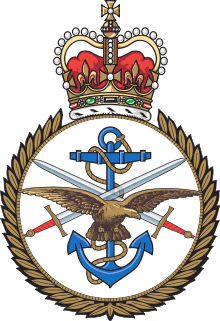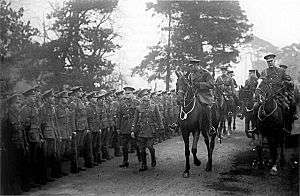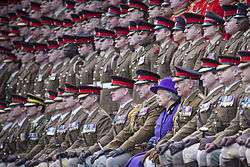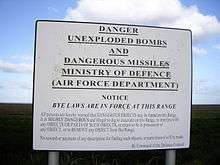Commander-in-chief of the British Armed Forces

The Commander-in-chief of the British Armed Forces, also described as commander in chief of the armed forces of the Crown, is a position vested in the British monarch, currently Queen Elizabeth II, who as sovereign and head of state is the "Head of the Armed Forces".[1][2] Long-standing constitutional convention, however, has vested de facto executive authority, by the exercise of Royal Prerogative powers, in the prime minister and the Secretary of State for Defence. The Prime Minister (acting with the support of the Cabinet) makes the key decisions on the use of the armed forces.[3][4] The Queen however, remains the ultimate authority of the military, with officers and personnel swearing allegiance only to the monarch.[5]
A new constitutional convention appears to have become enshrined since the 2003 war in Iraq, whereby the UK will only take military action (other than in circumstances of having to immediately react defensively) with the consent of the House of Commons. Ultimately however The Queen can exercise such at will. As well as the Military the UK Police forces also swear allegiance only to the Monarch, not the Government. This is to ensure that Government Officials (including the Prime Minister) can be arrested for committing indictable offences just as any normal citizen, and are therefore not 'above the law' unlike the Monarch.
The Crown and Government
The Ministry of Defence is the Government department and highest level of military headquarters charged with formulating and executing defence policy for the Armed Forces; it employed 103,930 civilians in 2006.[6][7] The department is controlled by the Secretary of State for Defence (or "the Defence Secretary") and contains three deputy appointments: Minister of State for the Armed Forces, Minister for Defence Procurement, and Minister for Veterans' Affairs.

Responsibility for the management of the forces is delegated to a number of committees: the Defence Council, Chiefs of Staff Committee, Defence Management Board, and three single-service boards. The Defence Council, composed of senior representatives of the services and the Ministry of Defence, provides the "formal legal basis for the conduct of defence".[7][8] The three constituent single-service committees (Admiralty Board, Army Board, and Air Force Board) are chaired by the Secretary of State for Defence.
The Chief of the Defence Staff is the professional head of the Armed Forces and is an appointment that can be held by an Admiral, General or Air Chief Marshal (four-star officers). Before the practice was discontinued in the 1990s, those who were appointed to the position of CDS (professional head of the Armed Forces) had been elevated to the most senior rank in their respective service (a five-star officer).[9] The CDS, along with the Permanent Under Secretary, are the principal advisers to the departmental minister. The three services have their own respective professional chiefs (likewise four-star officers): the First Sea Lord who is also Chief of Naval Staff, the Chief of the General Staff and the Chief of the Air Staff.
Historic office of Commander-in-Chief
From 1660 until 1904 the professional head of the Army was known as the Commander-in-Chief and as such had significant independence and power. Under the Commonwealth Government, the Commander-in-chief was a de facto head of state.
Naval, Military and Air commands
Until 2012 each of the three services also had one or more commands with a (four-star) commander-in-chief in charge of operations. These were, latterly: Commander-in-Chief Fleet (CINCFLEET – sharing a Command HQ with Commander-in-Chief Naval Home Command (CINCNAVHOME)), Commander-in-Chief, Land Forces (CINCLAND) and Commander-in-Chief Air (CINCAIR). (At one time there were many more Naval, Military and Air Commands, each with (in many cases) their own Commanders-in-Chief.)
Since 2012, however, full operational command has been vested in the three Chiefs of Staff, and the appointment of distinct Commanders-in-Chief has been discontinued. This change was implemented in response to the 2011 Levene report, which advised that it would serve to "streamline top-level decision-making, simplify lines of accountability..., remove duplication between the posts and also provide impetus to the leaning of the senior leadership".[10] New three-star appointments (Fleet Commander, Commander Land Forces) mirror the old ones, but these are subordinate officers with delegated command responsibility, rather than Commanders-in-Chief.




Colonial Governors
In the colonies of the English Empire, and subsequently the British Empire, the duties of Lords Lieutenant were generally performed by the Commander-in-Chief or the Governor. Both offices may have been occupied by the same person.
By way of an example, this is still the case in Britain's second, and oldest remaining, where the Royal Navy's headquarters, main base, and dockyard for the North America and West Indies Station was established following independence of the United States of America. The colony had raised Militia and Volunteer forces since official settlement in 1612 (with a troop-of-horse added later), and a small force of regular infantry from 1701 to 1783. A large regular army garrison was built up after 1794, and the reserve forces faded away following the conclusion of the American War of 1812 as the local government lost interest in paying for their upkeep. From this point until the 1960s, Governors were almost exclusively senior officers of the Royal Artillery or Royal Engineers who were also military Commanders-in-Chief (and initially also Vice Admirals). Attempts to rekindle the militia without a Militia Act or funds from the colonial government were made throughout the century under the authorisation of the Governor and Commander-in-Chief, but none proved lasting. The colonial government was finally compelled to raise militia and volunteer forces (the Bermuda Militia Artillery and the Bermuda Volunteer Rifle Corps by act in the 1890s (the Bermuda Cadet Corps, Bermuda Volunteer Engineers, and Bermuda Militia Infantry were added at later dates), and these fell under the Governor and Commander-in-Chief, as well as under operational control of his junior, the Brigadier in charge of the Bermuda Command (or Bermuda Garrison, which included the regular as well as the part-time military (as opposed to naval) forces in the colony. Although the Royal Naval and the regular army establishments have been withdrawn from Bermuda, the Governor of Bermuda remains the Commander-in-Chief (though most recent office holders have not been career army officers) of the Royal Bermuda Regiment (a 1965 amalgam of the BMA and BVRC, which had both been re-organised in line with the Territorial Army after the First World War).[11][12]
See also
References
- ↑ Queen and Armed Forces, royal.gov.uk. Archived 13 April 2015 at the Wayback Machine.
- ↑ The Royal Prerogative SN/PC/03861, House of Commons of the United Kingdom. Retrieved on 2013-05-12.
- ↑ Governance of Britain, July 2007. Retrieved on 2013-05-12.
- ↑ Review of the Royal Prerogative Powers: Final Report, Ministry of Justice, October 2009. Retrieved on 2013-05-12.
- ↑ "Whose hand is on the button?". BBC. 2 December 2008. Retrieved 2009-03-14.
- ↑ Civilian personnel by budgetary area and grade equivalence, at 1 April each year Archived 26 January 2009 at the Wayback Machine., dasa.mod.uk
- 1 2 Defence Organisation, mod.uk
- ↑ Defence Council and Chief of the Defence Staff, armedforces.co.uk
- ↑ Hansard (1998), House of Commons Written Answers, publications.parliament.uk
- ↑ "An independent report into the structure and management of the Ministry of Defence" (PDF).
- ↑ travis.smith-simons (3 March 2016). "The Governor of Bermuda". www.gov.bm.
- ↑ {{cite web|url=http://www.thebermudian.com/heritage/419-the-good-governor%7Ctitle=The Good Governor. Biographic article on Major General Sir [[William Reid (British Army officer)-William Reid], KCB, FRS, Governor and Commander-in-Chief of Bermuda from 1839 to 1846. The Bermudian magazine|publisher=}}